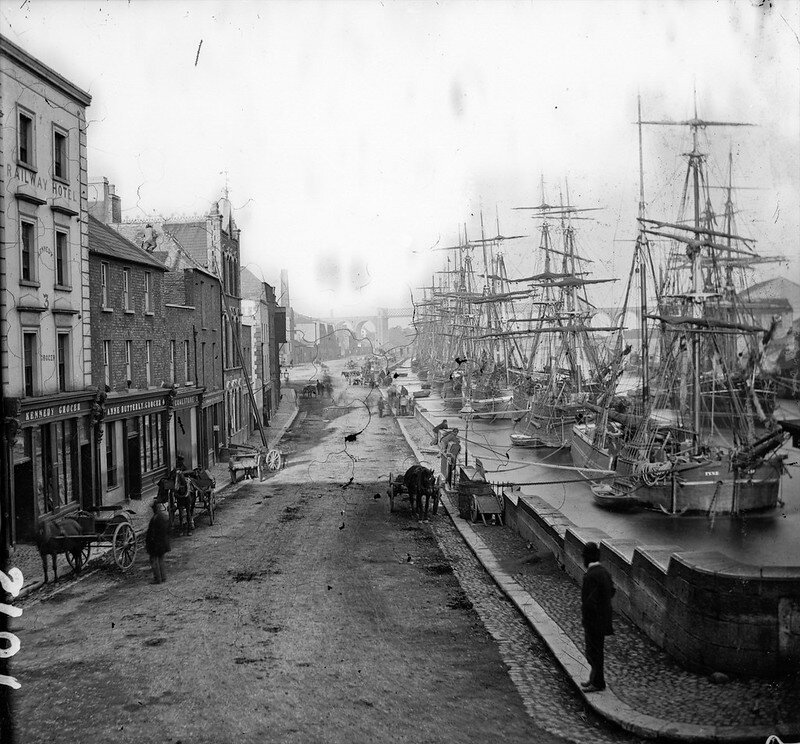Victorian Towns and People
The National Library in Dublin has a fascinating collection of historic photographs that date from around the middle of the nineteenth century. I enjoy searching through them to find inspiration for characters in my novels and for authentic information about period clothes, houses, carriages, towns and country pursuits.
(The photographs reproduced here have no known copyright)
DUBLIN city centre in late-19TH century
There are numerous photographs taken in the late-nineteenth century of O’Connell Bridge in Dublin and they provide interesting snapshots of the people, businesses and modes of transport of the late Victorian era. Here are two such photographs depicting first the building of the statue of Daniel O’Connell and the widening of the bridge, and the second one with the completed sculpture.
Carlisle Bridge, as it was first called, was built to the design of architect James Gandon (who designed the Customs House and Emo Court) and the bridge opened to pedestrians in 1792 and to carriage traffic in 1794. By the 1850s it had become so congested that apparently it needed policemen with batons to keep the crowds under control and the construction of a wider bridge, designed by Bindon Blood Stoney, began in 1877. Stoney was Chief Engineer to the Dublin Port and Docks Board. The new bridge was so wide it was almost square in shape, spanning 45 metres of the Liffey and being 50 metres wide.
The building of the Daniel O’Connell monument at the bottom of O’Connell St (formerly Sackville Street) and the widening of the bridge. The new bridge opened in 1882 and was renamed O’Connell Bridge. (Photo: National Library, Dublin)
Below is a photograph taken in 1890 of the new O’Connell Bridge with the statue of Daniel O’Connell on the far side. As you can see, horse drawn trams were still used in the last decade of the nineteenth century, and the bridge looks much wider than it does today, probably because of the lack of traffic. I wonder what went on in the Gun Powder Office at No. 56 on the left of the bridge.
The new O’Connell bridge in 1890 was wider than it was long. It spanned 45 metres of the River Liffey and was 50 metres in width. You can see famous landmarks at this time: the newly erected statue of Daniel O’Connell at the far side of the bridge, the General Post Office (GPO) with its pillars on the left half way up the street and Nelson’s Column at the top in the centre, which had to be taken down in 1966 after it was damaged by an explosive attack.
other historic towns in ireland
This is Limerick Railway Station in 1907 with an array of carriages awaiting the arrivals. Inside the railings are the more expensive carriages and outside are the side cars, or jaunting cars. Both could be privately owned or for hire.
Main Street in Wexford in 1895 with its delivery carts. I have done the walking tour of Wexford town, with a map of historical buildings and stories and it was interesting and well worth the effort.
Wexford was the local town in my novel ‘The Family Shadow’ and this photograph helped with historical detail. (Photo: National Library, Dublin)
Another photograph of Main Street in Wexford taken by Lawrence Studios in 1895. (Photo: National Library, Dublin)
A crowded Eyre Square in Galway with a horse-drawn omnibus in the foreground. Possibly taken on a market day. (Photo: National Library, Dublin)
North Quay, Drogheda in 1883. The lure of tall ships and you can imagine the sailors arriving and heading for the taverns in the town.
(Photo: National Library, Dublin)
One of my favourites, this is Eyre Square in Galway in 1886 and shows the Bianconi Royal Mail carriage ready to leave. (Photo: National Library, Dublin)
An inspiring photograph is this one of the Royal Mail carriage leaving Eyre Square with passengers bound for Oughterard and Clifden on the Bianconi route. It’s reported that the carriage left Galway at 9 a.m. and arrived at Clifden at 7 p.m. You can imagine what it was like jolting over those roads heading for the coastline of Connemara with a sea fog and rain on the wind.
The different characters on board always amuse me and it’s entertaining to guess who they were. They could easily have stepped out of a Dickens’ novel.
I asked readers which one they would select as the villain in a mystery novel and the majority chose the nonchalant bearded gentleman standing at the back, followed closely by the old woman with the dark veil, clutching her baskets.
North Quay in Drogheda in 1883 was an interesting place for a stroll with its tall ships and tales of the sea. There is a wonderful story added to the National Library comments on Flickr about a man who lived on this street who swapped a bible for a monkey, presumably with one of the sailors. The monkey used to escape across the rooftops, shimmy down into other houses and steal objects, which it brought back to the attic of its owner’s house. When the monkey’s hoard was eventually unearthed, they discovered things pilfered from the local police station! Not even a cat burglar could get away with that one.
This is not a town in Ireland but a photograph from the National Library of an Irish family from Wexford who emigrated to America and they are shown here at their new home.
The Family Shadow is a historical mystery with dual timeline suspense and long-buried family secrets.









